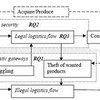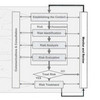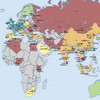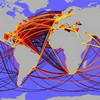 With 90% of world trade carried by sea, the global network of ships criss-crossing the oceans provide perhaps the most important mode of transportation, not only for human mobility and for the exchange of goods, but also for the spread of invasive species that “hitch-hike” with these ships, particularly in the ballast tanks. These invasive species carried along these global shipping lanes are perhaps not so much a risk to the supply chain, but a risk stemming from the supply chain. In order to find out how these species travel and where they come from, in The complex network of global cargo ship movements, a team from Germany has mapped the worldwide movements in the maritime shipping network.
With 90% of world trade carried by sea, the global network of ships criss-crossing the oceans provide perhaps the most important mode of transportation, not only for human mobility and for the exchange of goods, but also for the spread of invasive species that “hitch-hike” with these ships, particularly in the ballast tanks. These invasive species carried along these global shipping lanes are perhaps not so much a risk to the supply chain, but a risk stemming from the supply chain. In order to find out how these species travel and where they come from, in The complex network of global cargo ship movements, a team from Germany has mapped the worldwide movements in the maritime shipping network.
16363 ships, one year
Invasive species is perhaps not the first that comes to mind when thinking of risks in maritime supply chains, a topic I have covered on an earlier occasion. Nonetheless, Prof. Dr. Bernd Blasius of the Institute for Chemistry and Biology of the Marine environment (ICBM) at the Carl von Ossietzky University Oldenburg mapped the itineraries of 16,363 cargo ships during the year 2007 to construct a network of links between ports.
On a map, it looks like this:

The worldwide maritime network also plays a crucial role in today’s spread of invasive species.
Two major pathways for marine bioinvasion are discharged water from ships’ ballast tanks and hull fouling. Even terrestrial species such as insects are sometimes inadvertently transported in shipping containers. In several parts of the world, invasive species have caused dramatic levels of species extinction and landscape alteration, thus damaging ecosystems and creating hazards for human livelihoods, health, and local economies. The financial loss due to bioinvasion is estimated to be $120 billion per year in the United States alone
Interestingly, the researcher find that most ships can be classified in three categories: bulk dry carriers, container ships and oil tankers. These three categories also have distinct mobility patterns and make up separate networks within the larger network.
An important characteristic of the network are differences in the movement patterns of different ship types. Bulk dry carriers and oil tankers tend to move in a less regular manner between ports than container ships. This is an important result regarding the spread of invasive species because bulk dry carriers and oil tankers often sail empty and therefore exchange large quantities of ballast water. The gravity model, which is the traditional approach to forecasting marine biological invasions, captures some broad trends of global cargo trade, but for many applications its results are too crude.
Unsurprisingly, container ships follow regularly repeating paths because they are a directpart of many send consumer supply chains, whereas bulk dry carriers and oil tankers move less predictably between ports. More surprising perhaps is that the directed network of the entire cargo fleet is noticeably asymmetric, with 59% of all linked pairs of ports being connected only in one direction.
Results
The following table shows the results of the investigation:
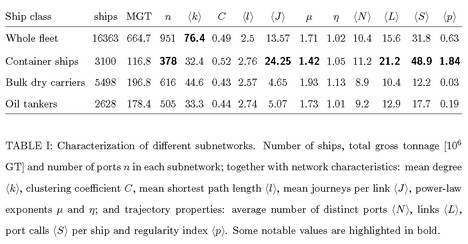
Container ships typically follow set schedules visiting several ports in a fixed sequence along their way, thus providing regular services. Bulk dry carriers, by contrast, appear less predictable as they frequently change their routes on short notice depending on the current supply and demand of the goods they carry.
The researchers also compare the worldwide airport network (WAN) to the global cargo shipping network GCSN):
The high asymmetry of the GCSN has not been found in the WAN, indicating that ship traffic is structurally very different from aviation. Rather than being formed by the accumulation of back and forth trips, ship traffic seems to be governed by an optimal arrangement of unidirectional, often circular routes.
Reference
Pablo Kaluza, Andrea Kölzsch, Michael T. Gastner, & Bernd Blasius (2010). The complex network of global cargo ship movements Journal of the Royal Society Interface arXiv: 1001.2172v1
Download
Author links
- icbm.de: Bernd Blasius
- icbm.de: Andrea Kölzsch
- santafe.edu: Michael T Gastner (presumed)
- jacobs-university.de: Pablo Kaluza
Links
- tu.no: Havets pulsårer
- technologyreview.com: The Global Shipping Network is finally revealed
Related
- husdal.com: Risks in maritime supply chains
- husdal.com: The BBC box is back

